Techniques and Tools to Teach Vocabulary
 By Sarah Tantillo
By Sarah Tantillo
When it comes to vocabulary instruction, teachers have many, many questions.
Here are just a few: “How can I fit vocabulary in with everything else I have to do? How should I pick the words? What should my quizzes look like? And can you give me something that will work that won’t take eight hours a week to prepare?” This post answers those questions and others.
The first step is to prepare your lists. I recommend using the free Vocabulary.com to either find pre-existing lists or create your own.
How to Find Vocab Words for Texts You Teach
- Sign up for a FREE Vocabulary.com account.
- If you want to FIND a list for a book you’re teaching, go to LISTS, then select the appropriate genre (e.g., Literature, Non-fiction, Morphology & Roots), and enter the name of the text.
- If you’re teaching a common text, your search will turn up more than one list. Look for the “official” list, which is labeled by the genre, attributed as “by Vocabulary.com,” and likely to be the most comprehensive. Here’s an example:
You will see that this book actually has three lists:
Before the Story, Part I
Part II
Part III
The vocabulary list you will see on each of the above links includes a user-friendly definition and shows each word as it is used in the text. Keep in mind that there may or may not be enough context clues in these initial sentences; often there are not.
Fortunately, this website provides numerous other example sentences with ample instructive/directive context: All you have to do is click on each word, and you will find multiple examples of usage—for example, the word Legacy.
How to Make Your Own Vocabulary List
You have two options:
- Open an existing list (see above for how to do that) and select “Copy this list to…” and “…New List.” You will thus turn this list into your own list, which you can name whatever you like, and you can modify the list or the example sentences.
- Create your own list from scratch here: https://www.vocabulary.com/lists/vocabgrabber
Dump in all of the words you want to teach into the box and give this list a name; then the website generates user-friendly definitions. Once you click on “Edit,” you can “Browse Example Sentences” and select the ones you want to include. These example sentences use the words in context, and they are great for building “Hypothesis Sheets” to introduce the words.
Once you’ve created your list, use the following resources from The Literacy Cookbook’s “Building Robust Vocabulary” page, explained below.
- Introduce new words with the “Hypothesis Sheet” (see examples below). Save time by copying and pasting context-laden sentences from your Vocabulary.com list. I recommend addressing 4-5 words in a Do Now (3 minutes for the “Hypothesis Sheet,” 7 minutes to go over the words with the “Note-taking Sheet”). PS: It’s a good idea to give multiple sentences for each word, to show students different nuances of meaning.
- Use a “Note-taking Sheet” to go over the words with the class, co-creating user friendly definitions and one more sentence per word. Have students take notes (see example below). Use the Vocabulary.com user-friendly definitions as a guide.
- Use various tools to give students opportunities to practice using/playing with words during Do Nows and HW (see examples below). If you have a word wall, consider running the “Word Wall Game” as follows:
-
- See “Sample Vocabulary Quiz” for ideas about how to build your quizzes. Note: Matching is a no-no because students can simply guess, and this doesn’t show they understand how to use the words. Require students to EXPLAIN their answers. If you decide to use the “scenario” approach, be sure to train students how to use that approach before you put it on a quiz.
Resources
HYPOTHESIS SHEET: Vocabulary from Somewhere in the Darkness
Vocabulary words: entwine, beckon, silhouette, fragment
DIRECTIONS: Underline any CLUE WORDS that help you form your hypotheses.
What do these words have in common? _________________________
What does “cede/ceed” mean? _________________________________
For the complete Root sheet, click Root of the Week HYPOTHESIS SHEET.
For the complete Notes sheet, click Vocabulary NOTES for Somewhere in the Darkness
For the complete Practice sheet, click Vocabulary PRACTICE for Somewhere in the Darkness.
Vocabulary HOMEWORK
Directions: Complete the sentences with logical responses. NOTE: There is NOT one right answer.
- If two people entwine their fingers, they are probably __________________
- If a stranger beckons you, you should ______________________________
- If you saw the silhouette of a man with a knife, you would _____________________________________________________________
- If your mom found her vase in fragments, she would probably __________
For the printable Homework sheet, click here.
For the complete sample Quiz, click SAMPLE Vocabulary Quiz.
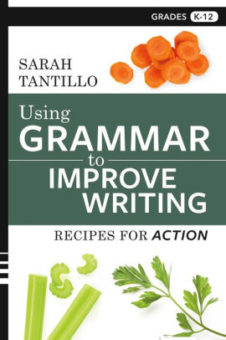
Sarah consults with schools on literacy instruction, curriculum development, data-driven instruction, and school culture building. She taught English and Humanities in both suburban and urban public schools, including the high-performing North Star Academy Charter School of Newark. For more information visit her website The Literacy Cookbook and her TLC Blog.


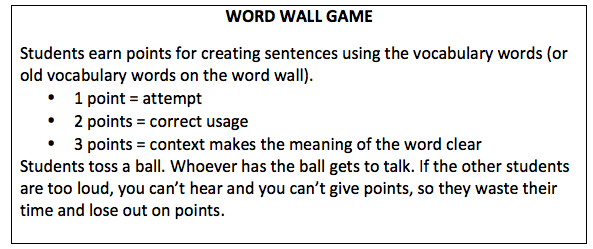
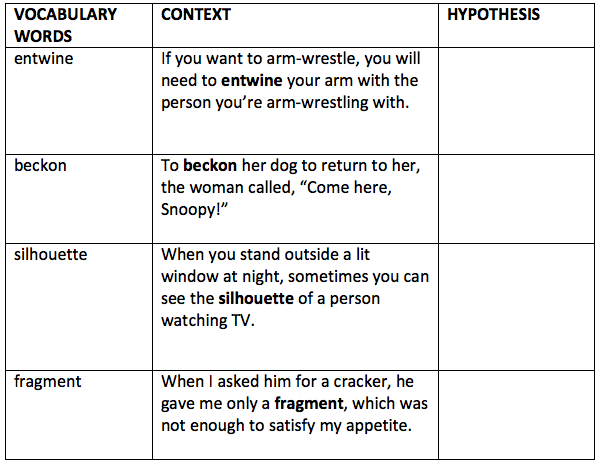
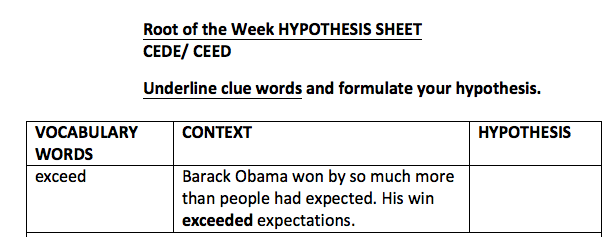
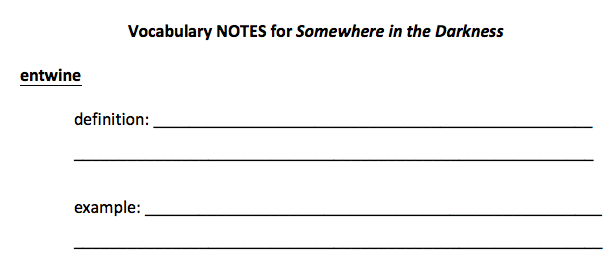
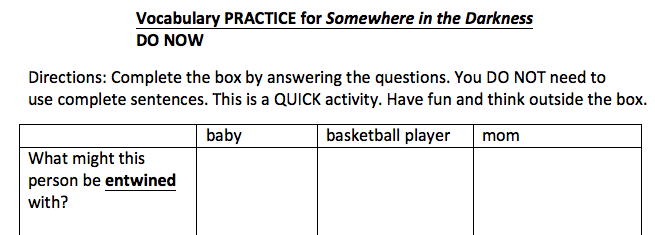
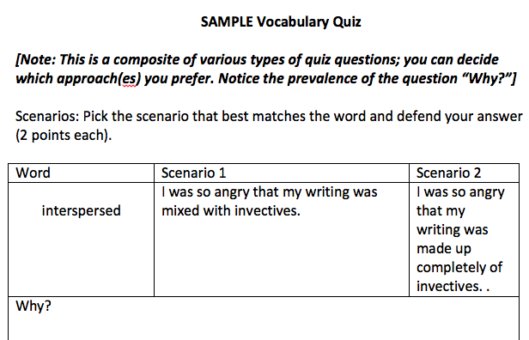



































Another way to teach vocabulary that’s fun, successful, and progressive is PicLits. Visual learning and word banks the you can apply to WRITING as well as vocabulary. – Terry, founder